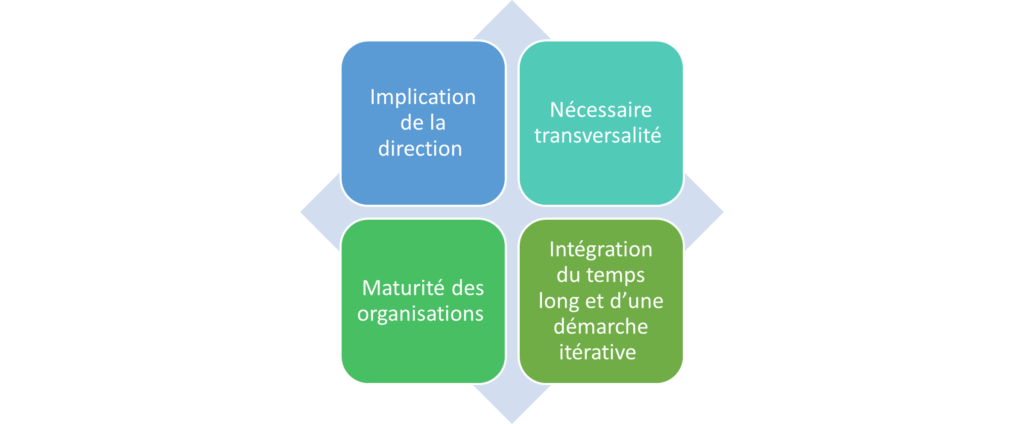Read our previous articles on "The foundations of a CSR Purchasing policy" :
- Pillar 1 "Protecting people and the planet": read the article
- Pillar 2 "Collaboration with the supplier" & Pillar 3 "Digitization". : read the article
---------------
While we have seen in previous episodes that a Responsible Purchasing policy can only exist if the entire supply chain is committed to a product or service that is designed to be sustainable, the notion of individual and collective responsibility is the cement of this philosophy.
As a reminder, theResponsible Purchasing approach is based on 4 pillars:
- Protecting mankind and the planet: the obvious choice
- Collaboration with suppliers: a guarantee of security and future-proofing
- Digitization: the key to an efficient Responsible Purchasing strategy
- Social and societal criteria: the ultimate in Responsible Purchasing
In this article, we focus on pillar 4.
PILLAR 4 - Social and societal criteria
 Buyers' liability
Buyers' liability
| After awareness and guidance on the origin of products, on the routing and manufacture of goods. But also the need for a balanced commercial relationship or the necessary data management. In recent years, buyers have become involved in a wide-ranging social and societal program. |  |
With the 2013 collapse of the Rana Plazza and its 1,135 deaths among the teams of textile subcontractors, it became obvious to raise awareness and commit distributors and tier 1 suppliers to shared responsibility for working conditions in sourcing. The Duty of Vigilance Act was therefore enacted in 2017 and aims to prevent serious violations of human rights, fundamental freedoms, personal health and safety and the environment caused by parent companies and ordering companies or their subsidiaries. Purchasing departments of companies with more than 5,000 employees must now meet three preventive obligations: the obligation todraw up a vigilance plan, the obligation to publish it and the obligation to implement it.
But today's society considers that the responsibility of buyers in this minimum foundation of respect for the human being must find echoes and applications in our more advanced economies.
 |
Here again, aResponsible Purchasing strategy must apply the various laws already in force on labor law, both internally and externally.
|
- Internally, all CSR social criteria must be applied to the Purchasing population (respect for formal relationships, skills development, health and safety protection, social dialogue, anti-discrimination, etc.). The latest example of this is the March 2006 agreement on equal pay for men and women.
- Externally, purchasing departments need to be concerned about these social commitments with their suppliers via social audits, or even raise their awareness and commit them to compatible social approaches. This is a relatively sensitive criterion, since, firstly, buyers' willingness to take a step back is proportional to how they are treated within their own organization. Secondly, suppliers are not necessarily inclined to share this aspect of their business, which they consider to be "private", politically and financially significant. Depending on the maturity of the respective organizations, the distributor may consider including a CSR criterion in the remuneration of its buyers.
 Consumer communications
Consumer communications
The other social aspect of Responsible Purchasing concerns communication with the consumer: information on the normal use of products or services must be clear, accessible and transparent to the consumer. It is the buyer's responsibility to verify that the data has been collected and is accurate, so that it can be properly disseminated throughout the company via all channels, right up to the consumer. Buyers must be fully aware of their responsibility to consumers, who, if dissatisfied, will immediately interact with their ecosystem via social networks: the risk to a brand's image is today the enemy of any corporate strategy.
 |
In conclusion, we can see how Responsible Purchasing is part of a co-responsible relationship, optimizing collaboration in the spirit of a general value chain of economic, social and environmental responsibility, right down to the consumer. The closer this collaboration, the more effective it is in terms of innovation or environmental protection, for example. This responsible collaboration takes on even greater significance in times of crisis: risk management becomes dynamic, the search for solutions is shared, brand preference is visible and the guarantee of supply is assured.
|
The Covid 19 crisis also highlights the CSR Purchasing initiative, which aims to promote local economic development through strategic choices of local partnerships and upstream integration. The strong notion of solidarity also points to the need to go ever further in partnerships with suppliers who integrate people who are far from employment or suffering from disabilities.
However, the implementation of a Responsible Purchasing strategy focuses above all on the following 4 points:

- Involvement of top management: reading Purchasing performance from a responsible strategy necessarily requires a paradigm shift and a much more global point of view. It can only work if the entire organization is committed to a CSR approach, fully sponsored by top management.
- The need for cross-functionality: a responsible purchasing strategy implies a complete investment in each subject, with a willingness to be pro-active in moving things in the right direction. Interdepartmental collaboration is essential if each department is to achieve its own specific CSR criteria.
- Organizational maturity: as we have seen, the CSR Purchasing approach is based on logic, regulations and standards, some of which have been in place for several decades. Applying these principles and tools remains the simplest, safest and most involving approach for organizations.
- Integration of a long-term, iterative approach: the sum total of criteria to be taken into account, and therefore the knowledge of products and suppliers that meet all the rules of a CSR purchasing strategy, can only be seen over the long term, especially if the collaboration involves industrial investment, for example. Distributors are sometimes afraid of long-term collaboration, which could be synonymous with a confusion between trust and sleepiness on the part of buyers. But it's precisely the iterative nature of the approach that should encourage buyers to revisit their conclusions regularly, while respecting their collaboration, and always through the prism of a performance grid and ranking. The difference lies in the attitude " How can I make this supplier evolve? " Rather than in the attitude of the "kost killer" buyer faced with a "kleneex" supplier.
Whereas the concentration of players used to be the norm in many markets, the covid crisis and the emergence of this environmental and social emergency have seen the emergence of many new companies responding to new consumer expectations. The implementation of a genuine strategy is therefore a real possibility, and a real competitive advantage for retailers.
Finally, it's important to remember that any CSR approach, including purchasing, must be part of a framework that everyone can recognize. As this engaging philosophy is based on a number of highly regulated criteria, it would be very tricky to be too haphazard, as this could result in greenwashing, which would ultimately be very damaging to a company's brand image. That's why the wisest thing to do is to adopt an approach backed by a standard or label. In this case, for purchasing, the label Relation Supplier Achats Responsables (Responsible Purchasing), which is based entirely on the ISO 20400 standard.
| What's important is not the level you're starting from, but your determination to create long-term value through an Eco Purchasing policy that's sustainable, responsible, supportive, fair and local. |  |
By Catherine Fedrigo

